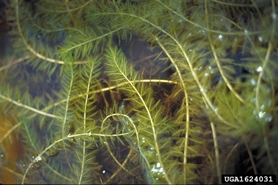Invasive aquatic plants confirmed at West Okoboji Lake
August 9th, 2023 by Ric Hanson
(Des Moines, Iowa) – The Iowa Department of Natural Resources (DNR) says recently discovered Eurasian watermilfoil is growing throughout the canals near Miller’s Bay and The Harbor canals on West Okoboji Lake in Dickinson County. Brittle naiad was also found in the Triboji lagoon. No Eurasian watermilfoil or brittle naiad was found in the main lake of West Okoboji or the other lakes in the Iowa Great Lakes chain. “We are developing a management plan and working with local stakeholders and communities to develop a plan of action for the coming weeks,” said Mike Hawkins, fisheries biologist for the Iowa DNR. “We’re getting permits in place in case the community and DNR decide that a herbicide treatment of the canals and lagoon is the best option.”
The DNR is asking boaters and other users in these areas to be extra vigilant to help prevent the spread of these invasive aquatic plants elsewhere in West Okoboji or the other lakes in this chain. “It is critical to clean all vegetation from boats and equipment before moving out of the canals and lagoon into the main lake to prevent the spread of Eurasian watermilfoil and brittle naiad into West Okoboji Lake,” said Kim Bogenschutz, the DNR’s aquatic invasive species program coordinator.
The Iowa DNR Aquatic Plant Management team monitors the vegetation in the Iowa Great Lakes each year. The monitoring has been especially important this summer. East Okoboji, Upper Gar, Minnewashta, and Lower Gar Lakes were aggressively treated with herbicide to eradicate Eurasian watermilfoil discovered in those lakes late last summer. The DNR worked closely with lake associations, cities, Dickinson County, and other organizations to develop and fund that treatment plan. Surveys conducted this week found no Eurasian watermilfoil growing in East Okoboji or the three lower chain lakes.

EurasianWatermilfoil
Eurasian watermilfoil, an invasive rooted aquatic plant native to parts of Europe and Asia, can spread quickly and outcompete beneficial native plants. It reproduces by fragmentation, which means small pieces of it grow into new plants and form thick beds. Iowa’s Aquatic Invasive Species Program has been a national leader in control efforts to stop Eurasian watermilfoil for the past 30 years. “Iowa DNR has successfully eradicated the plant in many lakes throughout the state. The size and complexity of the Iowa Great Lakes present real challenges for management,” explains Hawkins. “Lakes with healthy, diverse native aquatic plant communities may be less susceptible to an infestation that takes over the native plant community.”
“Boaters and anglers can unintentionally spread Eurasian watermilfoil, brittle naiad, and other aquatic invasive species if they do not take the proper precautions before going between lakes and after each time out on the water,” said Bogenschutz.
Clean, Drain, Dry is a simple three step process that boaters need to follow every time they move from one body of water to another.
- CLEAN any plants, animals or mud from the boat and equipment before you leave a water body. With the current infestations in the canals and lagoon, you must also check boat props and other parts of the boat where vegetation fragments could get caught before entering the main lake.
- DRAIN water from all equipment (motor, live well, bilge, transom well, bait bucket) before you leave a water body.
- DRY anything that comes into contact with water (boats, trailers, equipment, boots, clothing, dogs). Before you move to another waterbody either: Spray your boat and trailer with hot, high-pressure water; or Dry your boat and equipment for at least five Days.
- Never release plants, fish or animals into a water body unless they came out of that water body and empty unwanted bait in the trash.
It is illegal to possess or transport prohibited aquatic invasive species, such as Eurasian watermilfoil, in Iowa. Boaters must also drain all water from boats and equipment before leaving a water access and must keep drain plugs removed or opened during transport.
Find more information about aquatic invasive species and a list of infested waters in the 2023 Iowa Fishing Regulations booklet or on the DNR’s website at www.iowadnr.gov/ais.





